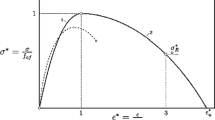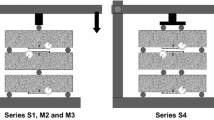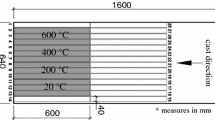Abstract
The incorporation of steel fibres can compensate the inherently brittle behaviour of high strength concrete. This paper studies the residual mechanical behaviour of thermally damaged high strength steel Fibre Reinforced Concrete (FRC). The type and content of fibres were included as variables, a mortar and a normal strength fibre concrete were also tested. Two exposure conditions werre selected, I hour at 500°C and 24 hours at 150°C. FRC follow similar residual compressive behaviour as the plain concrete, but the presence of fibres lead to slight increase in strength and in the stress at which cracks initiate. Flexural tests on notched beams were performed (RILEM TC 162-TDF recommendation). It was found that the shape of the load-deflection curves in FRC exposed to 150°C was similar to the undamaged concrete. The reductions in flexural strength were lower in FRC than in plain concrete, and the equivalent post-peak strength was less affected than first-crack strength, showing the effect of fibre reinforcement. For the most severe exposure condition the degradation of the material is reflected by an increased non-linearity, nevertheless some FRC still exhibited a strengthening type behaviour and kept an almost constant load capacity during the post-peak.
Résumé
L'incorporation des fibres d'acier dans le béton peut compenser le comportement fragile du béton de haute résistance. Est étudié dans ce travail le comportement mécanique résiduel du béton de haute résistance renforcé de fibre d'acier (BRF) endommagé par la température. On a considéré comme variables le type et le dosage de fibres; et on a aussi étudié un mortier et un béton de résistance normale. On a adopté deux conditions d'exposition à haute température, 1 heure à 500°C et 24 heures à 150°C. Les bétons renforcés de fibres d'acier (BRF) présentent un comportement résiduel en compression identique à celui du béton normal, mais la présence de fibres produit un léger accroissement de la résistance à la compression et de la contrainte où la formation de fissures commence. On a réalisé des essais de traction en flexion dans des éprouvettes prismatiques entaillées (recommandation de la commission technique RILEM TC 162-TDF). Les courbes charge-déformation du BRF exposé à 150°C présentent la même forme que celles du béton de référence. Par rapport au béton normal, les BRF ont une réduction inférieure de la résistance en flexion; de plus, la résistance équivalente après pic a·été moins affectée que la résistance des premières fissures, mettant en évidence l'effet de la présence des fibres. On a trouvé un accroissement de la non-linéarité dans les échantillons plus endommagés, alors que les BRF présentaient toujours un comportement de renforcement et maintenaient une capacité de charge pratiquement constante pendant l'après-pic.
Similar content being viewed by others
References
Giaccio, G. and Zerbino, R., ‘Fibre reinforced high strength concrete: evaluation of failure mechanism’, in ‘High Performance Concrete and Performance and Quality of Concrete Structures’, Proceedings of an International Conference, Recife, Brasil, (Ed: V.M. Malhotra, P. Helene, E.P. Figueiredo, A. Carneiro, ACI International, SP-207-5, 2002) 69–90.
Horiguchi, T., Takana, T., Saeki, N. and Lin, T.D., ‘Effect of fibre reinforcement on residual properties of high-strength concrete under elevated temperature’, in ‘Innovation in Design with Emphasis on Seismic, Wind and Environmental Loading; Quality Control and Innovation in Materials/Hot Weather Concreting’, Proceedings of an ACI International Conference, Cancun, Mexico, (ACI International, SP-209-40, 2002) 53–64.
Luo, X., Sun, W. and Chan, S.Y.N., ‘Effects of heating and cooling regimes on residual strength and microstructure of normal strength and high-performance concrete’,Cement and Concrete Research 30 (3) (2000) 379–383.
Bažant, Z. and Kaplan, M., ‘Concrete at High Temperatures’, 1st Edn (Longman, Essex, UK, 1996).
Baker, G., ‘The effect of exposure to elevated temperatures on the fracture energy of plain concrete’,Mater. Struct. 29 (190) (1996) 383–388.
Papayianni, M. and Valiasis, T., ‘Residual mechanical properties of heated concrete incorporating different pozzolanic materials’,Mater. Struct. 24 (140) (1991) 115–121.
Zhang, B., Bicanic, N., Pearce, C.J. and Balabanic, G., ‘Residual fracture properties of normal-and high-strength concrete subjected to elevated temperatures’,Mag. of Concrete Research 52 (2) (2000) 123–136.
Mohamedbhai, G.T.G., ‘Effect of exposure time and rates of heating and cooling on residual strength of heated concrete’,Mag. of Concrete Research 38 (136) (1986) 151–158.
Luo, X., Sun, W. and Chan, S.Y.N., ‘Residual compressive strength and microstructure of high performance concrete after exposure to high temperature’Mater. Struct. 33 (229) (2000) 294–298.
Barragán, B., Giaccio, G. and Zerbino, R., ‘Fracture and failure of thermally damaged concrete under tensile loading’,Mater. Struct. 34 (239) (2001) 312–319.
Barragán, B., Di Maio, A., Giaccio, G., Traversa, L. and Zerbino, R., ‘Effects of high temperature on residual mechanical and transport properties of concrete’, in ‘Durability of Concrete’, Proceedings of a CANMET/ACI International Conference, Barcelona, (Ed: V. M. Malhotra, ACI International, SP-192-60, 2000) 983–1000.
Di Maio, A., Giaccio, G. and Zerbino, R., ‘Non-destructive tests in the evaluation of concrete exposed at high temperatures’,ASTM Journal Cement, Concrete and Aggregates 24 (2) (2002) 58–67.
Phan, L.T., ‘Fire performance of high-strength concrete: a report of the state-of-the-art’, NISTIR 5934, US Dep. of Commerce, Gaithersburg, Maryland 20899, 1996, 105.
Giaccio, G. and Zerbino, R., ‘The performance of fibre reinforcement in concrete exposed at high temperatures’, in ‘Innovation in Design with Emphasis on Seismic, Wind and Environmental Loading; Quality Control and Innovation in Materials/Hot Weather Concreting, Proceedings of an ACI International Conference, Cancun, Mexico (Ed: V. M. Malhotra, ACI International, SP-209-40, 2002) 733–754.
RILEM TC 162-TDF, ‘Test and design methods for steel fibre reinforced concrete. Recommendations’,Mater. Struct. 33 (225) (2000) 3–5.
RILEM TC 162-TDF, ‘Test and design methods for steel fibre reinforced concrete—Bending test, Final Recommendation’,Mater. Struct. 35 (253) (2002) 579–582.
Barragán, B.E., ‘Failure and toughness of steel fiber reinforced concrete’, Doctoral Thesis, Universidad Politécnica de Cataluña, Barcelona, 2002, 151 p.
Traina, L.A. and Mansour, S.A., ‘Biaxial strength and deformational behaviour of plain and steel fibre concrete’,ACI Materials Journal 88(4) (1991) 354–362.
Mangat, P.S. and Motamedi Azari, M., ‘Influence of steel fibre reinforcement on the fracture behaviour of concrete in compression’,Int. Journal of Cement Composites and Lightweight Concrete 6 (2) (1984) 219–232.
Shah, S.P. and Chandra, S., ‘Critical stress, volume change, and microcracking of concrete’,ACI Materials Journal 65 (9) (1968) 770–781
Giaccio, G., Rocco, C., Violini, D., Zappitelli, J. and Zerbino, R., ‘High strength concretes incorporating different coarse aggregates’,ACI Materials Journal 89 (3) (1992) 242–246.
Author information
Authors and Affiliations
Rights and permissions
About this article
Cite this article
Giaccio, G.M., Zerbino, R.L. Mechanical behaviour of thermally damaged high-strength steel fibre reinforced concrete. Mat. Struct. 38, 335–342 (2005). https://doi.org/10.1007/BF02479299
Received:
Accepted:
Issue Date:
DOI: https://doi.org/10.1007/BF02479299




